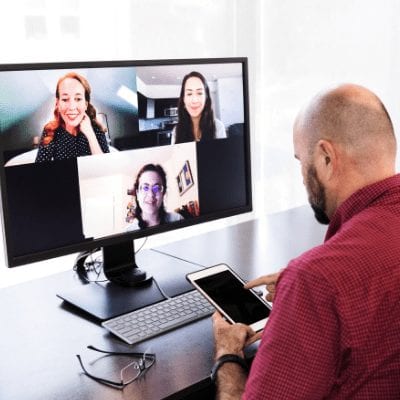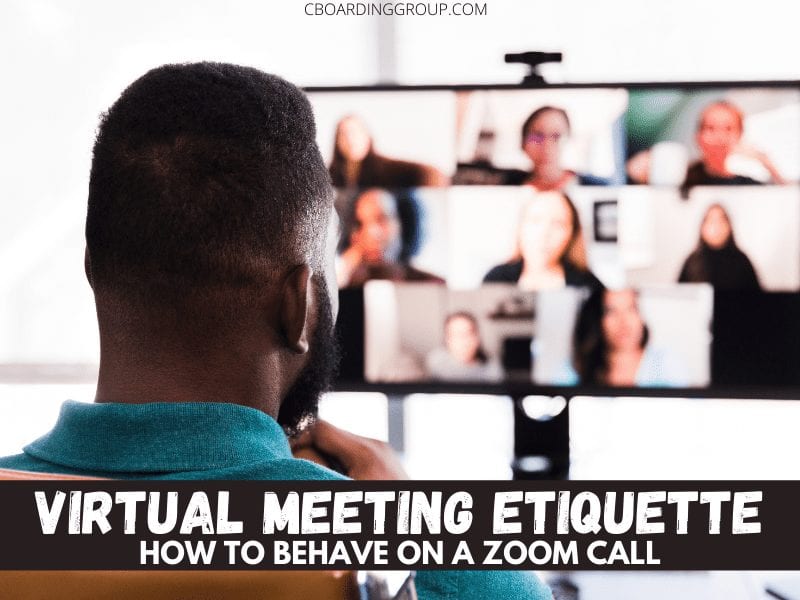Virtual team meetings are now a part of the daily work routine for millions of workers and they are here to stay. Conducting yourself in a professional manner while on a virtual call can improve your team meetings and help your career. Here are 12 tips for proper virtual meeting etiquette.
Technologies like Zoom, Microsoft Teams, Google Meet, and many other similar solutions, have enabled an entire workforce to seamlessly transition to remote work. In the face of the great pandemic of 2020, millions upon millions of employees found themselves suddenly working from home and via Zoom-like calls.
Sure, remote technology, including video conference calls, had been around for several years, but until 2020 it was lightly adopted. The preponderance of meetings was still held in brick and mortar conference rooms at company HQs across the world. Perhaps that “one remote employee” would dial-in, or maybe a few conference rooms would virtually gather together, but the widespread, near-total adoption of virtual conferencing had not yet occurred.
Until 2020.

As companies scrambled to move their workforce remote while still maintaining productivity they quickly found that it actually wasn’t that hard. Some companies were already ahead of the game, having invested in technologies like Microsoft Teams and Google Meet (and other similar tools) that integrated video conferencing into the larger productivity suites.
Other companies found themselves a tad behind, but quickly caught up as they found how easy it was to implement technologies like Zoom and how easily employees adapted. Suddenly, most of the work we thought “had to be done in the office” was able to be done remotely – and in many cases, was actually being done better.
Suddenly, things could be done from home. The entire workforce flashed forward through five years of evolution, landing where we would have eventually landed anyway. We did it because we had to.
In the wake of this radical and exciting change, new norms were quickly identified. New rhythms, new WFH gear, behaviors, and yes, even a new professional etiquette became necessary. A general relaxing of the often uptight nature of the corporate world ripped through everyone’s home offices (who were working from home while kids tried their hand at online school and spouses shared workspaces). But, some new rules remained, and some new rules emerged.
Virtual Meeting Etiquette: some things have changed (and some haven’t!)
With the emergence of this virtual landscape, a new set of unwritten rules governing employee behavior and new pitfalls and opportunities for employees simultaneously navigating the virtual workspace and their career has also emerged. This new virtual meeting etiquette can help you and your organization to find its footing in this new, fun, and frankly overdue world.
Here are the 12 virtual meeting etiquette tips – and how you ought to behave on a Zoom call (or whatever conferencing platform you use).
- Turn your camera on
- Invest in faster internet
- Minimize Multitasking
- The mute button is your friend
- Learn how to use the virtual conferencing tool
- Turn your phone notifications down or off
- Participate, engage & add value
- Watch your body language
- A quiet, dedicated home office is super helpful
- Be understanding: everyone’s WFH situation is different
- It’s ok to look good
- Keep your virtual backgrounds professional
Let’s dig into each of these virtual meeting etiquette tips.
Turn your camera on
The most important virtual meeting etiquette advice we can give you is this: turn your camera on. It’s that simple. There are two primary reasons why turning your camera on is a good thing:
- Shows the meeting participants you care about their meeting
- Good for your career
Now that we all basically just work from now, we’ve lost the incredibly valuable opportunities we once had in the office to network with colleagues, peers, and power brokers through face to face interaction. It’s harder to build your reputation, establish your credibility, and frankly to be “visible.”

Like it or not, office politics are a thing. Being noticed, being visible, making your presence felt, etc, are important parts of career advancement. If you only work remotely, then the only time people will see you is on video calls. Turn your camera on.
There’s a natural resistance to being “on camera” for many people. Perhaps they are ashamed of their home office, or they didn’t comb their hair. Or maybe they really just want to multi-task. But, think about this in the context of being in the office. You wouldn’t multi-task if you were in an actual meeting nor would you cover yourself with a bedsheet so they can’t see you in the conference room, would you? And you’d probably have combed hair.
Turn your camera on, ok?
When to turn your camera off:
You are eating. You have to blow your nose. If you need to need to get up – and don’t have pants on. Your kid zips into the rooms wearing nothing but his underoos and an apron for a cape.
Invest in faster internet
Whether your company is kind enough to help you with this or you have to do it yourself, fast internet is a must-have. Slow internet will result in a poor virtual meeting experience. For example, you may not be able to use your camera or your audio quality will cut in and out or be choppy.
Upgrade your internet to the fastest you can afford and it will improve your virtual meeting experience and allow you to focus more on actively participating in the meeting than struggling just to be in the meeting.
Minimize Multitasking
Raise your hand if you’ve ever been in a conference room and the leader asked everyone to close their laptops. Pay attention, right! Why shouldn’t this be any different when you are remote.
It’s tempting to multi-task while on a video call, but try to minimize this as much as you can. Stay engaged in the call itself. If it’s a waste of your time…then don’t go.
Sure, the occasional IM, or quick reply to an email is going to be necessary. Maybe even take a quick call from your boss, but as a general rule, try to minimize your multitasking.
Turning your camera on helps with this by the way…just saying.
The mute button is your friend

Unless you are actively engaged in a conversation, mute your video call. Background noise, dogs barking, doorbells ringing, keyboard keys clacking, your allergy attack. No one really wants to hear all of that. And while today’s remote work culture has normalized a lot of the chaos that can occur in a remote work environment, muting when you can is the polite thing to do.
Learn how to use the virtual conferencing tool
Remember when we first starting using video conferencing technology as part of our daily routine? Yeah, it was rough. “Hey, Jim, can you please mute your line?” Or struggling to figure out how to share your screen, or one of the other basic features of the platform.
Yeah, it was rough. And kinda funny. It’s funny enough that Progressive Insurance made a series of commercials lampooning this behavior:
Do yourself (and your colleagues) a favor and learn how to use your virtual calling platform. Don’t be the person who always comes across like a technological rube on every single meeting. Figure it out. It’s really not that hard.
To help, here are some links to common video platforms and their basic training documentation:
Turn your phone notifications down or off
Quit looking at your instagram feed. Haha…no seriously, though, when you are on a call – especially one where you are presenting or actively engaging a lot (and thus will be off mute a lot) turn your phone notifications down. We can do without the beeps and boops all call. Just like you’d do in a physical meeting.
Participate, engage & add value
Since you took the time to attend the meeting you might as well participate. Ask questions, engage with the team. Participate and add value to the call. Don’t clam up. If you are an introvert it can be even easier to not engage on a virtual call than in person. Make the effort. Jump in.
For meeting leaders, be sure to give the virtual room time to engage. It’s ok to call on people too.
Watch your body language

Body language is a big deal whether you are in the office or working remotely on a video call. The difference is that it can actually be a little more pronounced when you are remote – particularly your facial expressions. Learn when it’s ok to lean back in your chair and be a little more casual and when you need to sit up straight and look into the camera, staying interested. Easy on the eye rolls, and remember it’s pretty easy to tell who’s not paying attention.
A quiet, dedicated home office is super helpful
Some of us are working out laundry rooms, our kid’s bedroom, the dining room, or basically wherever we can find a quiet spot for the day or hour. Many of us are not blessed with the financial wherewithal to have a dedicated home office. And that’s ok. To a point.
Yes, generally speaking, company culture adapted to the sudden rise in near-universal remote work and quickly became comfortable with employees working wherever they could. We didn’t care so much about the stack of laundry in the background, or the husband walking through the kitchen (as long as he had pants on) while you were on a call.

We were in crisis mode. Making the best of a bad situation. As such, we threw out many of the longstanding norms about “being super duper professional” or “hey, everyone be quiet, Mom’s on a call.” It wasn’t practical because we had our entire families jammed into our 2 bedroom apartment and near-constant deliveries of food or toilet paper.
A lot of those norms that were shattered will definitely stay as society “gets back to normal” (whatever that looks like post-pandemic), but over time some of the previous norms will start to creep back in.
Dedicated, quiet, acoustic friendly workspaces will always be better than working in a dining room next to a stack of unfolded towels with kids yelling at their Minecraft server. So, if you can, if your means allow it, a dedicated home office space will improve your virtual meeting participation.
- You might be interested in How to Upgrade your Home Office for under $50
Be understanding: everyone’s WFH situation is different
You’ve done it. I know you have. What are we talking about? Judging a colleagues home office. It’s hard not to.
One of the brilliant things to come out of the way in which video calls became the norm was that it happened so fast we were all forced to simply “deal” with whatever we or our employees were facing at home. No home office? Fine. Dogs barking? Yeah, me too. Kids losing their everloving minds? That happened yesterday.
Not everyone is cut out to work from home and not everyone has the most ideal WFH situation. Some do have the means for a dedicated, quiet office. Some have dogs, some have kids, some of have out of work spouses. Some have spouses who are teachers, and so on.
Every one’s work from home / remote work situation is a little different. That’s ok. Sure, it’d be nice if the dogs weren’t barking every time you came off mute, but we can all appreciate it because we’ve been there.
So yes, if you have dogs that bark all the time you should try to teach them to dial it back a bit, but it’s also more than ok to be understanding of the situation. We never know what our employees or colleagues are facing when the camera turns off.
It’s ok to look good
Remote work has normalized sweatpants once again. It’s nice to not have to get 100% ready every day. Really nice. But, that’s not an excuse to look like a slob. Don’t be afraid to clean yourself up. Shave, comb your hair, fix your hair, whatever. Try not to look like a homeless person on your team calls.
Consider taking and shower and getting ready for the day too. As we talk about in 17 Work from Home Tips, getting ready can improve your productivity and help create some demarcation from the now blurry home/professional life.
Keep your virtual backgrounds professional

Besides the elimination of the commute, the remote work trend brought us something else that was pretty darn awesome: the virtual background.
Popularized first by Zoom, then quickly followed by most video conferencing platforms, virtual backgrounds allowed meeting attendees to digitally superimpose pretty much anything they wanted behind them. And that’s where the fun began.
As employees struggled to find their new normal, suddenly working from home in spaces they’d not really prepped for this, they often were more than a little embarrassed by the fact they were literally working in a closet, or the laundry room or their kid’s nursery.
Virtual backgrounds helped us hide all of that chaos and even allowed us to have a little fun with our teams as we goofed around with backgrounds like burning dumpsters, or the Four Seasons Landscaping company. Some of us took this to another level, using green screens to improve our experience (a super wise, idea, btw) and some of us needed to be reminded of what’s appropriate and not appropriate for use in a corporate setting.
We encourage folks to use virtual backgrounds – just make sure you are using appropriate ones – even in one on one meetings.
Here at the CBoardingGroup, we have a massive repository of virtual backgrounds for many of the popular video conferencing platforms. And they are all free:
- Free Teams Backgrounds
- Free Google Meet Backgrounds
- Free Zoom Backgrounds
- Free Skye Backgrounds
- Free Cisco Webex Backgrounds
Go next level
Follow the aforementioned virtual team meeting rules and best practices and you can be sure to get the most out of your virtual conference calls. Your career outlook will improve, and your meetings will run a little smoother.
If you want to go even further, you can do things like upgrading your microphone to get better audio quality, add an external video camera for better video performance, and even upgrade your lighting. These are all good things to do, but they are secondary to the best practices and etiquette suggestions we’ve covered above.
In the meantime, happy Zooming!
Be sure to check out all of our remote work content including:
- 25 Great Home Office Gift Ideas
- How to avoid remote work burnout
- Hilarious WFH Memes
- The Workation: what is this madness (hint: it’s a remote work game changer)
- Work from Home Perks – what do employees want now?
Affiliate Disclosure: As an Amazon Associate I earn from qualifying purchases. I may also earn commissions from other affiliate programs as applicable.

